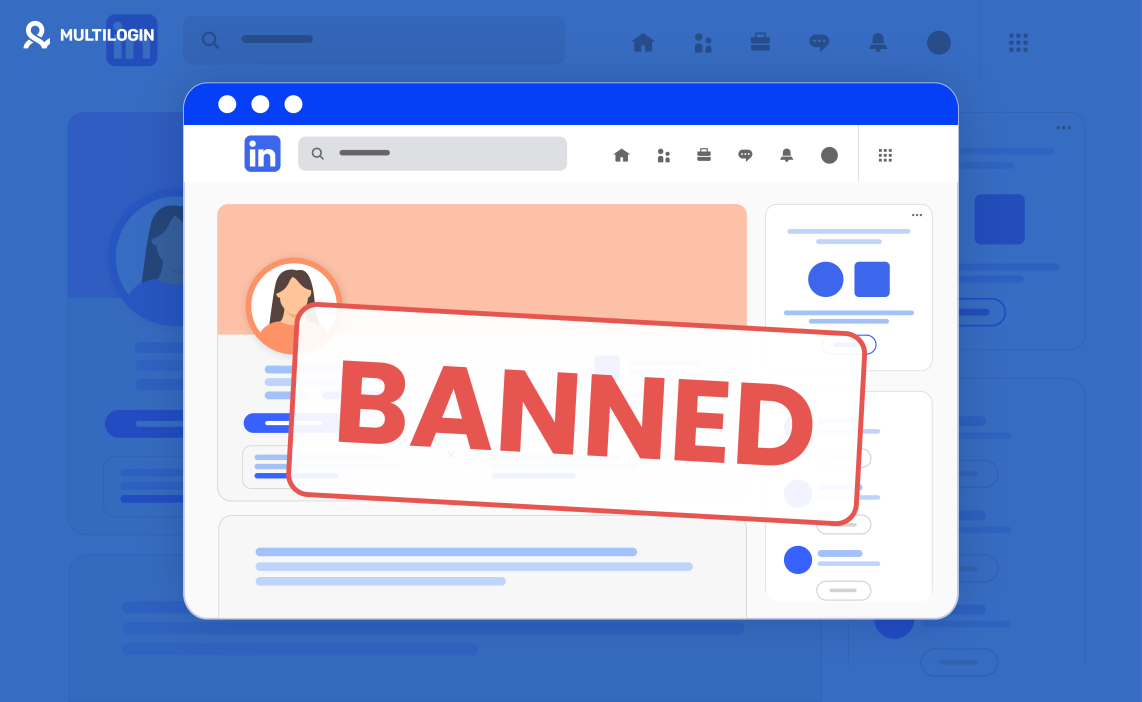Managing multiple LinkedIn accounts? Multilogin’s LinkedIn Proxy & Antidetect Bundle keeps you undetected!
LinkedIn has become an essential platform for professionals and businesses alike, providing a space to network, share ideas, and grow careers. However, like any social media platform, LinkedIn enforces strict guidelines to maintain the quality and integrity of its community.
Violating these guidelines, knowingly or unknowingly, can lead to penalties such as a shadow ban or even a complete ban from the platform.
This article will explore what it means to be shadow banned or banned on LinkedIn, how to avoid it, and what steps to take if you find yourself in this situation.
What is a LinkedIn Shadow Ban?
A shadow ban on LinkedIn occurs when your content or profile is restricted or hidden from others without any notification from LinkedIn. You might continue posting and interacting on the platform, but your posts may not be visible to others, drastically reducing engagement and visibility. This can be frustrating, especially if you’re using LinkedIn for business or personal branding.
How Can You Tell if You’re Shadow Banned?
Since LinkedIn doesn’t notify you of a shadow ban, it can be tricky to determine if you’ve been affected. Here are some signs that might indicate a shadow ban:
Sudden Drop in Engagement: If your posts typically receive a certain level of interaction and suddenly experience a significant drop, you might be shadow banned.
Decreased Visibility: If connections or followers no longer see your posts in their feeds, despite regular posting, a shadow ban might be the cause.
Reduced Searchability: Your profile may not appear in search results as often as before.
Using a LinkedIn shadow ban checker or tracking engagement metrics can help identify potential issues with visibility.
Common Reasons for Getting Banned on LinkedIn
LinkedIn enforces community guidelines and policies to ensure the platform remains professional and safe. Violating these guidelines can lead to temporary suspensions, permanent bans, or shadow bans. Here are some common reasons users might find themselves banned:
1. Spamming or Over-Posting
LinkedIn discourages spammy behavior, which includes posting too frequently, sending too many connection requests in a short time, or repeatedly sharing the same content. Spamming can lead to a LinkedIn automation ban, especially if you’re using third-party tools that automate posting or connections.
2. Inappropriate Content
Sharing content that is offensive, discriminatory, or violates LinkedIn’s content policies can lead to a ban. This includes posts, comments, and even private messages that are reported by other users.
3. Using LinkedIn Automation Tools
While automation tools can help manage tasks efficiently, LinkedIn strictly prohibits the use of unauthorized automation tools. If detected, using these tools can result in a LinkedIn automation ban or even a permanent ban from the platform.
4. Misleading Information
Creating a profile with fake information, impersonating someone else, or misleading users in any way can lead to an account ban. LinkedIn requires all users to maintain accurate and honest profiles.
5. Violating LinkedIn’s Terms of Service
Any activity that goes against LinkedIn’s terms of service, such as scraping data, misusing the platform for non-professional activities, or harassing other users, can result in a ban.
How to Avoid Getting Banned on LinkedIn
Preventing a ban is about understanding LinkedIn’s guidelines and adhering to best practices. Here’s how to stay in LinkedIn’s good graces:
1. Avoid Using Automation Tools
LinkedIn’s algorithms are adept at detecting automation tools, which can lead to an immediate LinkedIn automation ban. Instead, focus on organic growth strategies, such as engaging with content, building meaningful connections, and posting regularly within LinkedIn’s guidelines.
2. Stay Professional
Always ensure your content is professional and relevant to your audience. Avoid posting or sharing anything that could be considered offensive or inappropriate.
3. Don’t Spam
Limit the number of connection requests you send daily and avoid over-posting. Quality over quantity is key on LinkedIn. Make sure every interaction adds value to your network.
4. Verify Your Information
Ensure that all the information on your profile is accurate and up-to-date. Misleading or fake information can easily lead to your account being flagged and eventually banned.
5. Regularly Monitor Engagement
Keep an eye on your engagement metrics. If you notice a sudden drop, investigate the cause. Tools that act as a LinkedIn shadow ban checker can help identify issues with visibility.
What to Do If You Get Banned from LinkedIn
If you find yourself banned from LinkedIn, taking immediate action is crucial to restore your account. Here’s what you can do:
1. Review LinkedIn’s Community Guidelines
Before appealing, understand why you might have been banned. Reviewing LinkedIn’s community guidelines can provide insight into the possible violations.
2. Contact LinkedIn Support
Visit the LinkedIn Help Center to contact support and appeal the ban. Clearly explain the situation, especially if you believe the ban was a mistake. Provide any necessary evidence that supports your case.
3. Be Patient
After submitting your appeal, wait for LinkedIn’s response. The process might take some time, so patience is key. While waiting, refrain from creating new accounts, as this could worsen the situation.
4. Avoid Repeating Mistakes
If your account is reinstated, take note of what led to the ban and ensure you avoid similar actions in the future. Adhere to LinkedIn’s guidelines to maintain your account.
Frequently Asked Questions About LinkedIn Shadow Bans
How do I know if I'm shadow banned on LinkedIn?
You might be shadow banned on LinkedIn if you notice a sudden drop in engagement on your posts, reduced visibility of your content, or your profile not appearing in search results. Using tools to track your engagement metrics can help identify if a shadow ban is in place.
How long does a LinkedIn ban last?
The duration of a LinkedIn ban can vary depending on the severity of the violation. Temporary bans can last from a few days to several weeks, while more serious violations can result in permanent bans.
How do I remove a shadow ban from my account?
To remove a shadow ban, first, review and comply with LinkedIn’s guidelines. Make sure your content adheres to their community standards. You can also reach out to LinkedIn support to appeal the ban if you believe it was applied incorrectly.
How to get unshadowbanned?
Getting unshadowbanned involves cleaning up your account by removing any content that may have triggered the ban. Consistently following LinkedIn’s guidelines and appealing the ban to LinkedIn support can help lift the shadow ban over time.
Can you recover from a shadow ban?
Yes, recovering from a shadow ban is possible. It requires careful adherence to LinkedIn’s guidelines and possibly appealing to LinkedIn support to review your account.
Can shadowban be lifted?
Yes, a shadowban can be lifted once LinkedIn determines that your account no longer violates their guidelines. This process may take some time, so patience and consistent good behavior on the platform are essential.
Can you get banned from LinkedIn?
Yes, LinkedIn can ban accounts that violate their terms of service or community guidelines. This can range from temporary suspensions to permanent bans, depending on the severity of the violation.
How do I know if I am restricted on LinkedIn?
If you’re restricted on LinkedIn, you may notice limited functionality, such as being unable to send connection requests, post updates, or access certain features. LinkedIn may notify you via email or in-app messages if your account has been restricted.
What does getting shadowbanned look like?
Getting shadowbanned on LinkedIn often looks like a sudden drop in engagement, such as fewer likes, comments, and shares on your posts. Your content may not appear in the feeds of your connections, and your profile may not show up in search results.
Can I create a new LinkedIn account after being banned?
While it’s technically possible to create a new LinkedIn account after being banned, it’s not recommended. LinkedIn’s terms of service prohibit users from creating new accounts to circumvent a ban, and doing so could lead to another ban.
How to fix a restricted LinkedIn account?
To fix a restricted LinkedIn account, start by reviewing LinkedIn’s guidelines and identifying any potential violations. Remove any offending content and reach out to LinkedIn support to request a review of your account. Compliance with their guidelines is essential for regaining full access.
Why did LinkedIn lock me out?
LinkedIn may lock you out of your account if it detects suspicious activity, such as the use of unauthorized automation tools, multiple login attempts, or a violation of their community guidelines. If you believe the lockout is a mistake, contact LinkedIn support to resolve the issue.
Need to create multiple LinkedIn accounts without hassle? See how Multilogin makes it simple and safe!
Final Thoughts
LinkedIn is a powerful tool for networking, job searching, and business development. However, understanding and adhering to its guidelines is crucial to avoid a shadow ban or permanent ban.
Avoiding automation tools, maintaining professionalism, and monitoring your account for signs of issues are key to staying in LinkedIn’s good graces.
If you believe you’ve been unfairly banned or shadow banned, taking steps to appeal the decision and ensuring compliance with LinkedIn’s rules can help you restore your account and continue leveraging the platform effectively.
Remember, building a genuine, professional presence on LinkedIn is the best way to avoid penalties and maximize your opportunities.


